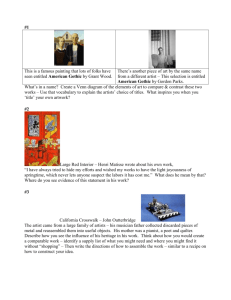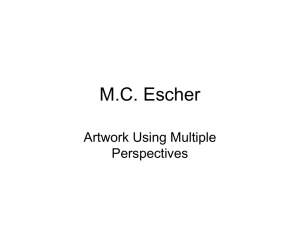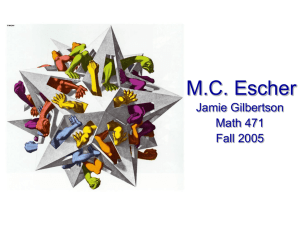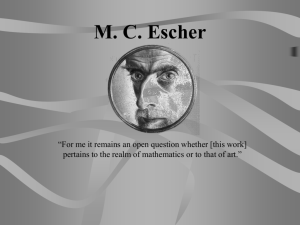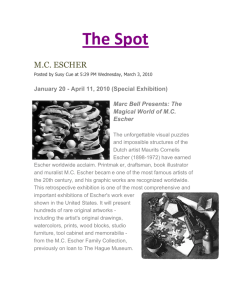M.C. Hammer
advertisement
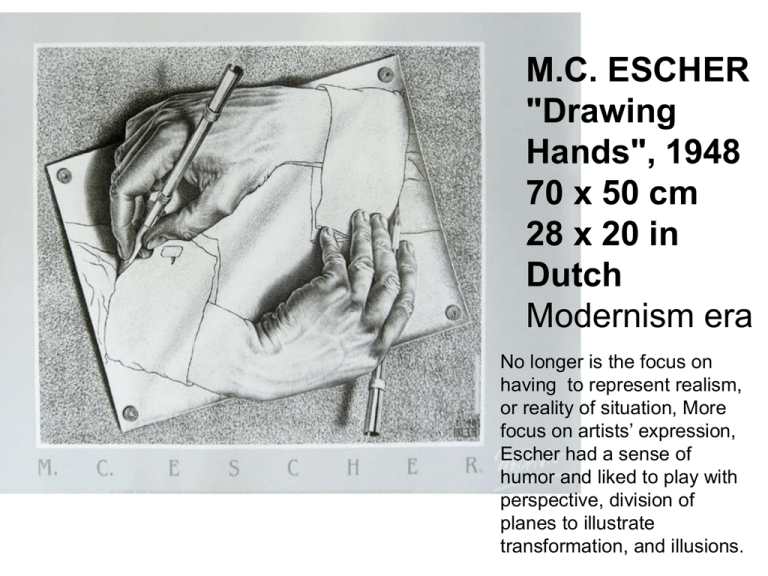
M.C. ESCHER "Drawing Hands", 1948 70 x 50 cm 28 x 20 in Dutch Modernism era No longer is the focus on having to represent realism, or reality of situation, More focus on artists’ expression, Escher had a sense of humor and liked to play with perspective, division of planes to illustrate transformation, and illusions. M Maurits Cornelius Escher was going to be an architect, according to his father. He decided that he liked graphic design better. (thank goodness, or all of our buildings would look like that). Conor O’Haleck 4th period c Escher http://de-bondt.eu/2009/09/05/default.aspx Relativity M.C. generally used the same art style throughout his life. He used movement quite a bit, often creating paradoxical paths through his art. See left, and try to follow the stairs with your eyes • Escher, Maurits. "M.C. Escher, Relativity." M.C. Escher. n.d. Global Gallery. 14 jan. 2010 <http://www.globalgallery.com/enlarge/20783/>. Waterfall Even though Escher’s movement drew the eye away from them, he always put people and interesting things in the background of his art. Day and Night Escher was very adamant about what he called “Division of the regular plane” which involved one “plane” or flat, square surface, as checkered shapes. These shapes would gradually become more detailed and complex, drawing the eye outward as they transformed into the real shapes that they used to just represent. BARBARANO,CIMINO Timeline 1898 Born in the Dutch Province of Friesland. 1907 Started learning carpentry and piano. He never officially graduated because he failed his final exams. 1913 Escher met his lifelong friend Bas Kist. 1917 Esher's family moved to Oosterbeek, Holland. 1918 Escher began private lessons and studies in architecture. 1919 Escher was not allowed to serve in the military because of poor health. 1921 Escher and his parents went to Italy to see the Riviera. 1922 Escher went to Italy in April. 1923 In March, Escher was still painting in Italy. 1924 In February, he did his first one man show, and June 12 married Jetta Umiker. 1925 Escher created his famous woodcuts, Days of Creation shortly after his brother died in a mountaineering accident. 1926 Escher and his wife bought a house. Also in late July his son George was born. 1930 The "Castrolva" was finished, and he had another son, Arthur. 1934 Escher and his family went to the sea shore. Meanwhile his work was doing well. 1935 Traveled to his parents house, and moved his family to Switzerland. 1936 Escher went to Alhambra to study Moorish tiling. 1937 Escher moved to Ukkel. 1939 Escher's father died June 14 . 1957 Escher was asked to do a wall painting for the Dutch city of Utrecht. 1960 Escher's first book of 76 works came out . It was called Grafiek en Tekeningen. 1962 Planned a trip to Boston; though it never took place. 1968 Escher's wife moved to Switzerland and stayed there the rest of her life. 1970 Had a round surgery and then moved to Lauren, Netherlands. 1970 A biography, The World of M.C. Escher, was published in Dutch. It was later translated into English. 1972 Escher died on March 27. He was 73. Quest, Think. "Timeline of M. C. Escher." M.C. Escher. n.d. Thinkquest. 14 Jan. 2010 <http://library.thinkquest.org/J0112302/index.html>. • • • • • • Proportion Contrast Tint Shade Value Scale • Not on vocabulary just to discuss: • Grid Vocabulary: • Value the element of art that describes the lightness or darkness of an object. (depends on how much light a surface reflects.) • Shade a dark value of a hue made by adding black to it. • Tint a light value of a hue made by mixing white to it. Puzzle Project Proportion scale grid Puzzle Project- worksheet • o
